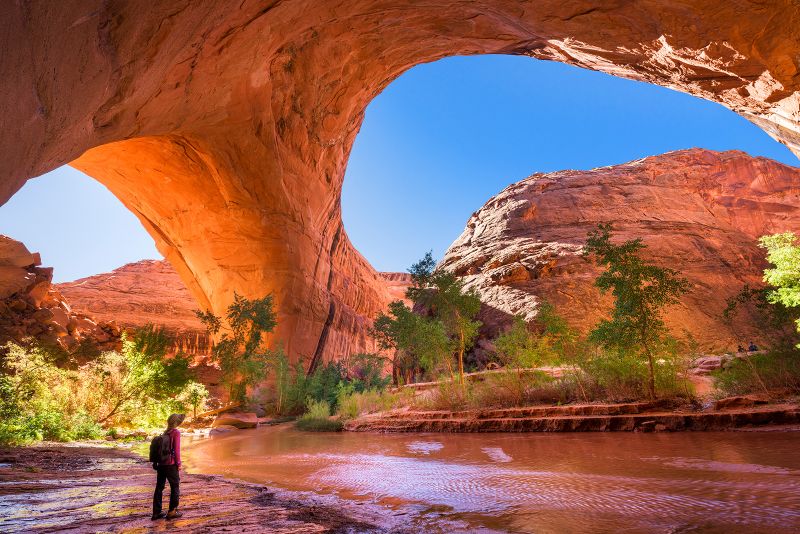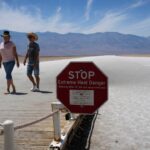Editor’s Observe: The views expressed on this commentary are solely these of the author. CNN is showcasing the work of The Dialog, a collaboration between journalists and teachers to offer information evaluation and commentary. The content material is produced solely by The Dialog.
CNN —
Outside recreation is on observe for an additional record-setting yr. In 2022, US nationwide parks logged greater than 300 million visits – and meaning much more folks on roads and trails.
Whereas analysis exhibits that spending time outdoors is nice for bodily and psychological well being, lengthy traces and gridlocked roads could make the expertise rather a lot much less enjoyable. Crowding additionally makes it tougher for park employees to guard wildlife and fragile lands and reply to emergencies. To handle the crowds, some parks are experimenting with timed-entry car reservation techniques and permits for fashionable trails.
For all of their recognition, nationwide parks are only one subset of US public lands. Throughout the nation, the federal authorities owns greater than 640 million acres (2.6 million sq. kilometers) of land. Relying on every website’s mission, its makes use of could embody logging, livestock grazing, mining, oil and gasoline manufacturing, wildlife habitat or recreation – typically, a number of of those directly. In distinction, nationwide parks exist solely to guard a number of the most vital locations for public enjoyment.
In my work as a historian and researcher, I’ve explored the historical past of public land administration and the function of nationwide parks in shaping landscapes throughout the Americas. Many public lands are prime leisure territory and are additionally turning into more and more crowded. Discovering options requires guests, gateway communities, state companies and the out of doors business to collaborate.
Alternate options to nationwide parks
The US authorities is the nation’s largest land supervisor by far. Federal property makes up 28% of floor land space throughout the 50 states. In Western states like Nevada, the federal footprint may be as massive as 80% of the land. That’s largely as a result of a lot of this land is arid, and lack of water makes farming troublesome. Different areas which can be mountainous or forested weren’t initially seen as priceless once they got here underneath US possession – however values have modified.
Public lands are extra various than nationwide parks. Some are scenic; others are simply open area. They embody all types of ecosystems, from forests to grasslands, coastlines, purple rock canyons, deserts and ranges coated with sagebrush. Additionally they embody battlefields, rivers, trails and monuments. Many are distant, however others are close to or inside main metropolitan areas.
Many individuals who love climbing, fishing, backpacking or different out of doors actions know that nationwide parks are crowded, and so they typically search different locations to take pleasure in nature, together with public lands. That development intensified through the Covid-19 pandemic, when lockdowns and social distancing protocols motivated folks to get outdoors wherever they might.
The rise of distant work has additionally fueled a inhabitants shift towards smaller Western cities with entry to open area and good web entry for videoconferencing. Well-liked distant work bases like Durango, Colorado, and Bend, Oregon, have grow to be generally known as “Zoom cities” – a recent tackle the outdated boomtowns that introduced folks west within the nineteenth century.
With these new populations, gateway communities near fashionable public lands face essential selections. Outside recreation is a robust financial engine: In 2021, it contributed an estimated US$454 billion to the nation’s financial system – greater than auto manufacturing and air transport mixed.
However embracing leisure tourism can lead native communities into the amenity entice – the paradox of loving a spot to dying. Recreation economies that fail to handle development, or that neglect investments in areas like housing and infrastructure, danger compromising the sense of place that pulls guests. However planning can proactively form development to keep up group character and high quality of life.
Migratory birds, together with snow geese, sandhill cranes and geese, make Bosque del Apache Nationwide Wildlife Refuge their fall and winter dwelling. Danny Lehman/The Picture Financial institution RF/Getty Photos
Broadening recreation
Folks use public lands for a lot of actions past a quiet hike within the woods. For example, the Phoenix District of the federal Bureau of Land Administration operates greater than 3 million acres throughout central Arizona for at the least 14 totally different leisure makes use of, together with climbing, fishing, boating, goal capturing, rock amassing and using off-road automobiles.
Not all of those actions are suitable, and plenty of haven’t historically been rigorously managed. For instance, goal shooters generally deliver objects like outdated home equipment or furnishings to make use of as improvised targets, then depart behind an unpleasant mess. In response, the Phoenix District has designated leisure capturing websites the place it gives targets and warns in opposition to capturing at objects containing glass or hazardous supplies, in addition to cactuses.
Snowboarding can also pose crowding challenges. Many downhill snowboarding services within the West function on public land with permits from the managing company – sometimes, the US Forest Service.
One instance, Bogus Basin Mountain Recreation Space is a nonprofit ski slope 16 miles from Boise, Idaho. Demand surges on winter weekends with recent powder, creating lengthy carry traces and crowded slopes.
The mountain is open for 12 hours a day, and Bogus Basin makes use of inventive pricing buildings for carry tickets to unfold crowds out. For instance, it attracts youthful skiers with discounted night time snowboarding and retired skiers through the week. Consequently, the parking zone solely stuffed up as soon as within the 2022-2023 season.
Native governments can assist discover methods to stability entry with inventive crowd administration. In Seattle, King County launched Trailhead Direct to offer transit-to-trails providers from Seattle to the Cascade Mountains. This method expands entry to the outside for metropolis residents and reduces site visitors on busy Interstate 90 and crowding in trailhead parking heaps.
Different cities have partnered with federal land companies to keep up path techniques, just like the Ridge to Rivers community outdoors Boise and the River Attain trails close to Farmington, New Mexico. This helps the cities present higher close by out of doors alternatives for residents and appeal to new companies whose staff worth high quality of life. Creating corridors from the “yard to the backcountry,” because the Bureau of Land Administration places it, can assist create vibrant communities.
A less-extractive view of public lands
For a few years, Western communities have seen public lands as locations to mine, log and graze sheep and cattle. Tensions between states and the federal authorities over federal land coverage typically replicate state resentment over selections made in Washington, D.C. about native sources.
Now, land managers are seeing a pivot. Whereas federal management won’t ever be welcome in some areas, Western communities more and more view federal lands as facilities and anchors for immense alternatives, together with recreation and financial development. For instance, Idaho is investing $100 million for upkeep and expanded entry on state lands, mirroring federal efforts.
As environmental regulation scholar Robert Keiter has identified, the U.S. has quite a lot of legal guidelines governing actions like logging, mining and vitality growth on public lands, however there’s little authorized steerage for recreation. As an alternative, companies, courts and presidents are creating what Keiter calls “a standard regulation of outside recreation,” little by little. By addressing crowding and the environmental impacts of recreation, I consider native communities can assist the U.S. transfer towards higher stewardship of our nation’s awe-inspiring public lands.
Editor’s Observe: Emily Wakild is the Cecil D. Andrus Endowed Professor for the Setting and Public Lands, Boise State College. She has obtained previous funding from the Nationwide Science Basis and the Nationwide Endowment for the Humanities.


